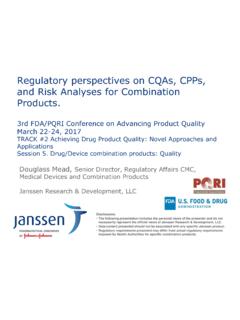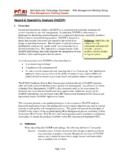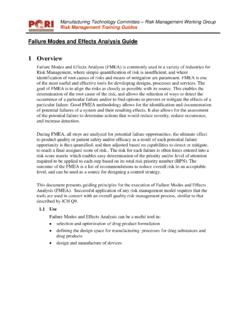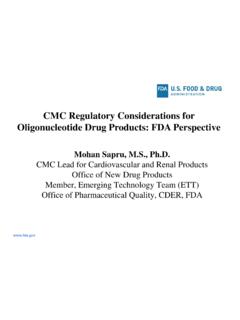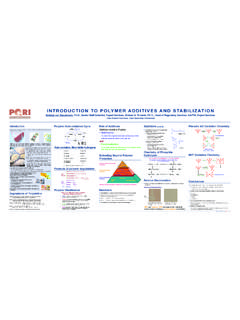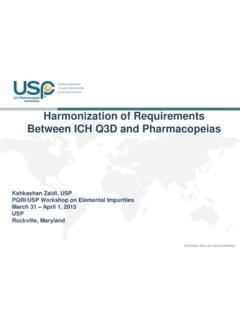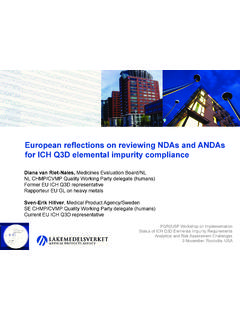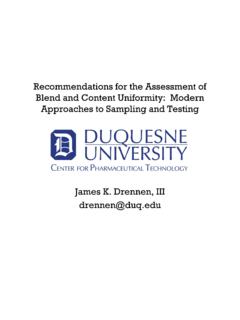Transcription of Biowaiver Approaches for Solid Oral Dosage Forms in ... - …
1 Biowaiver Approaches for Solid oral Dosage Forms in New Drug Applications Poonam R. Delvadia, Division of Biopharmaceutics\ONDP\OPQ\CDER\FDA PQRI BTC Webinar December 06, 2018 2 DISCLAIMER The presentation reflects the views of the presenter and should not be construed to represent FDA s views or policies 3 Presentation Outline Role of Biopharmaceutics In Vivo Bioavailability (BA) / Bioequivalence (BE) Assessment In Vitro and In Vivo Bridging for Assessment of Multiple Strengths and Product Changes Biowaivers Biowaiver Approaches and Case Examples 21 CFR (d)(2) Based Approach Biopharmaceutics Classification System (BCS)
2 Based Approach Risk Assessment for bridging drug product changes and multiple strengths Safe Space Approach Bracketing Approach Virtual BE In Vitro In Vivo Correlation (IVIVC) Concluding Remarks 4 Role of Biopharmaceutics Drug Product Quality Patient BIOPHARMACEUTICS Critical Material/Process/ Quality Attributes (CMA, CPP, CQA) , In Vitro Dissolution In Vivo Performance of Drug Product , Bioavailability (BA)/Bioequivalence (BE) data Science and Risk Based Approach Clinically Relevant Specifications Consistent Therapeutic Effect 5 In Vivo BA/BE Assessment Bioavailability Rate and extent of drug exposure Bioequivalence Absence of significant difference in the rate and extent of drug exposure These in vivo studies required as per 21 CFR for the drug product approval Pivotal role in Drug Product s Life-Cycle (Pre- and Post- Approval) To support major formulation and manufacturing changes To support the approval of multiple strengths 21 CFR.
3 21 CFR 6 Risk Level Assessment of Formulation/Manufacturing Changes Type of bridging needed based on the level of risk resulting from CMC changes and impact of change on product quality and in vivo performance FDA SUPAC IR Guidance (1995) FDA SUPAC MR Guidance (1997) In Vitro Bridging Minor Changes Unlikely to have any detectable impact Moderate Changes Could have a significant impact In Vivo Bridging (BA/BE studies) Major Changes Likely to have a significant impact Product Strengths Biowaivers 7 Biowaivers Waiver of In Vivo BA/BE Studies Requirements met as outlined in 21 CFR Supported by in vitro tests ( , dissolution testing) N=101 Biowaiver Requests ( Solid oral Dosage Forms ) (Year 2008 - 2015) Biowaiver is not needed Biowaiver is Applicable 8 Biowaiver Approaches for Solid oral Dosage Forms Biowaiver Approaches CFR 21 CFR (d)(2)
4 Safe Space Bracketing Approach Virtual BE IVIVC Risk Assessment* BCS * Applicable to bridge product changes and strengths when waiver requirements are not met 21 CFR FDA Guidance for Industry. Waiver of In Vivo BA/BE Studies for IR Solid oral Dosage Forms Based on a Biopharmaceutics Classification System. December 2017 FDA Guidance for Industry Extended Release oral Dosage Forms : Development, Evaluation, and Application of In Vitro/In Vivo Correlations 9 Biowaiver Approaches for Solid oral Dosage Forms Dissolution One of the key elements in these Biowaiver Approaches N=101 Biowaiver Requests ( Solid oral Dosage Forms ) (Year 2008 - 2015) 10 21 CFR (d)(2) Based Biowaiver Approach Biowaiver Approaches CFR 21 CFR (d)(2) Safe Space Bracketing Approach Virtual BE IVIVC Risk Assessment* BCS * Applicable to bridge product changes and strengths when waiver requirements are not met 11 21 CFR (d)(2)
5 Based Biowaiver Applicable for demonstration of product strength equivalence BA/BE can be demonstrated by an in vitro testing in lieu of an in vivo study for product strengths not tested in vivo if these strengths meet all the criteria set forth in the CFR In Vivo BA/BE data on the reference strength (commonly highest strength ) Same Dosage Form Same Manufacturing Process Compositional Proportionality In Vitro Dissolution Similarity PK linearity over therapeutic Dosage range Same drug release mechanism (MR Solid oral Dosage Forms ) Demonstration of the clinical need of the proposed strength (Higher strength ) Clinical safety and/or efficacy data on the proposed dose 21 CFR FDA Draft Guidance for Industry - Bioavailability and Bioequivalence Studies Submitted in NDAs or INDs General Considerations (2014)
6 12 strength Dependent Dissolution In vitro strength dependent dissolution profile is defined as the difference in drug dissolution profiles among strengths of the same oral drug product, , there is dissolution dissimilarity between test strength and reference strength ( , similarity factor f2 < 50) 13 21 CFR (d)(2) Case Example 1 strength Dependent Dissolution Drug Product X - Drug A Immediate release tablet Two strengths BCS Class 2 drug substance pH dependent solubility: Solubility decreases with increase in pH An in vivo BE study bridging lower strength (Phase 2 formulation) and higher strength [Phase 3/to-be-marketed formulation (TBM)] Major Formulation Change (Phase 2 to Phase 3) BE demonstrated for phase 2 and phase 3 formulation No PK data for lower strength (TBM) Biowaiver request for lower strength Suarez-Sharp, S.
7 ; Delvadia, , et. al. Regulatory Perspectives on strength -Dependent Dissolution Profiles and Biowaiver Approaches for Immediate Release (IR) oral Tablets in New Drug Applications. AAPSJ. 2016. May 18(3): 578-588 14 Case Example 1 strength Dependent Dissolution Multimedia dissolution comparing two strengths pH , pH , pH Dissolution similar at pH Dissolution not similar at pH and (f2 < 50) Dissolution dissimilarity strength dependent dissolution Sink condition differences pH 15 pH Multiunit Dissolution f2>50 Case Example 1 strength Dependent Dissolution pH Vertical dissolution comparison Multiunit dissolution similarity in pH and pH supported Biowaiver 16 21 CFR (d)(2) Based Biowaiver - Summary 21 CFR (d)(2)
8 Dissolution similarity is a requirement Factors causing strength dependent dissolution Sink condition differences Formulation differences Manufacturing process/Quality attribute differences ( , Hardness) Other strategies to support Biowaiver Horizontal dissolution comparison Indirect bioequivalence (BE) bridge Bracketing BE Approach Selection of the strategy when strength dependent dissolution is observed Factor causing strength dependent dissolution Type of in vitro/in vivo data generated as part of drug development Suarez-Sharp, S.; Delvadia, , et.
9 Al. Regulatory Perspectives on strength -Dependent Dissolution Profiles and Biowaiver Approaches for Immediate Release (IR) oral Tablets in New Drug Applications. AAPSJ. 2016. May 18(3): 578-588 17 Biopharmaceutics Classification System (BCS) Based Biowaiver Biowaiver Approaches CFR 21 CFR (d)(2) Safe Space Bracketing Approach Virtual BE IVIVC Risk Assessment* BCS * Applicable to bridge product changes and strengths when waiver requirements are not met 18 BCS Based Biowaiver Approach BCS framework Drug substance categorized into four classes Drug product rapidly dissolving ( 85% in 30 min) or very rapidly dissolving ( 85% in 15 min) in multimedia FDA Guidance for Industry.
10 Waiver of In Vivo BA/BE Studies for IR Solid oral Dosage Forms Based on a Biopharmaceutics Classification System. December 2017 Biowaiver application for IR Solid oral Dosage Forms containing BCS class 1 and 3 drug substances 19 BCS Based Biowaiver Approach Data To Support BCS Based Biowaiver Request BCS class 1 drug products BCS class 3 drug products Highly soluble (pH 1- ) Highly soluble (pH 1- ) Highly permeable T and R products are rapidly dissolving ( 85% in 30 min) T and R products are very rapidly dissolving ( 85% in 15 min) No excipients that affect rate or extent of drug absorption Qualitative sameness and quantitative similarity in formulation Similarity in dissolution profiles between T and R Similarity in dissolution profiles between T and R T Test Product R Reference Product 20 BCS Based Biowaiver Case Example 2 Biowaiver for Pharmaceutical Alternative BCS class 1 based Biowaiver for pharmaceutical alternative drug product Change from tablet to capsule Data to support High solubility High permeability Rapid dissolution in multimedia (>90% in 10 min)
